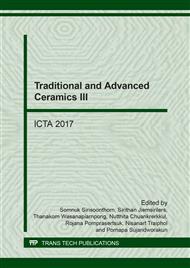p.28
p.34
p.40
p.44
p.51
p.58
p.65
p.71
p.77
The Utility of Rice Husk Ash from Biomass Power Plant of Nakhon Ratchasima Province for Synthesis of Nano-Silica for Using Cathode Material of Lithium Ion Battery
Abstract:
The high purity nanosilica materials could preparation from different synthesis route. In this research, rice husk ash was extracted into silica powder, by chemical extraction method. Then, chemical composition analysis with XRF technique. In addition, the extracted silica nanoparticles were analyzed by XRD technique. Physical structure of nanoscale particles by SEM imaging. The results showed that the chemical composition of rice husk ash consists mainly of silica. While, the extracted silica nanoparticles had a high silica content of 99.9999%. In addition, silica extracted with silica nanoparticles was confirmed by XRD at position 2θ ≈ 22° and the crystalline extracts were amorphous to the physical characteristics of the SEM images. In the future, nanosilicon powder may be used to synthesize lithium-ion batteries.
Info:
Periodical:
Pages:
51-57
Citation:
Online since:
April 2018
Authors:
Keywords:
Price:
Сopyright:
© 2018 Trans Tech Publications Ltd. All Rights Reserved
Share:
Citation:


